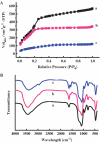Stimuli-responsive controlled-release system using quadruplex DNA-capped silica nanocontainers
- PMID: 20965972
- PMCID: PMC3045591
- DOI: 10.1093/nar/gkq893
Stimuli-responsive controlled-release system using quadruplex DNA-capped silica nanocontainers
Abstract
A novel proton-fueled molecular gate-like delivery system has been constructed for controlled cargo release using i-motif quadruplex DNA as caps onto pore outlets of mesoporous silica nanoparticles. Start from simple conformation changes, the i-motif DNA cap can open and close the pore system in smart response to pH stimulus. Importantly, the opening/closing and delivery protocol is highly reversible and a partial cargo delivery can be easily controlled at will. A pH-switchable nanoreactor has also been developed to validate the potential of our system for on-demand molecular transport. This proof of concept might open the door to a new generation of carrier materials and could also provide a general route to use other functional nucleic acids/peptide nucleic acids as capping agents in the fields of versatile controlled delivery nanodevices.
Figures





Similar articles
-
Biocompatible Phenylboronic-Acid-Capped ZnS Nanocrystals Designed As Caps in Mesoporous Silica Hybrid Materials for on-Demand pH-Triggered Release In Cancer Cells.ACS Appl Mater Interfaces. 2018 Oct 10;10(40):34029-34038. doi: 10.1021/acsami.8b13698. Epub 2018 Oct 1. ACS Appl Mater Interfaces. 2018. PMID: 30272435
-
Dual-cargo selectively controlled release based on a pH-responsive mesoporous silica system.Chemphyschem. 2015 Feb 23;16(3):607-13. doi: 10.1002/cphc.201402732. Epub 2014 Dec 9. Chemphyschem. 2015. PMID: 25492672
-
Lysozyme as a pH-responsive valve for the controlled release of guest molecules from mesoporous silica.Langmuir. 2012 Dec 18;28(50):17578-84. doi: 10.1021/la304152j. Epub 2012 Dec 5. Langmuir. 2012. PMID: 23173551
-
Cell microenvironment stimuli-responsive controlled-release delivery systems based on mesoporous silica nanoparticles.J Food Drug Anal. 2014 Mar;22(1):18-28. doi: 10.1016/j.jfda.2014.01.002. Epub 2014 Feb 1. J Food Drug Anal. 2014. PMID: 24673901 Free PMC article. Review.
-
Stimuli-Responsive Nanomachines and Caps for Drug Delivery.Enzymes. 2018;43:31-65. doi: 10.1016/bs.enz.2018.07.003. Epub 2018 Sep 14. Enzymes. 2018. PMID: 30244808 Review.
Cited by
-
DNA-aptamer gating membranes.Chem Commun (Camb). 2015 Mar 28;51(25):5471-4. doi: 10.1039/c4cc09660f. Chem Commun (Camb). 2015. PMID: 25633657 Free PMC article.
-
DNA Based and Stimuli-Responsive Smart Nanocarrier for Diagnosis and Treatment of Cancer: Applications and Challenges.Cancers (Basel). 2021 Jul 6;13(14):3396. doi: 10.3390/cancers13143396. Cancers (Basel). 2021. PMID: 34298610 Free PMC article. Review.
-
DNA Assembly-Based Stimuli-Responsive Systems.Adv Sci (Weinh). 2021 May 14;8(13):2100328. doi: 10.1002/advs.202100328. eCollection 2021 Jul. Adv Sci (Weinh). 2021. PMID: 34258165 Free PMC article. Review.
-
Rational design of guiding elements to control folding topology in i-motifs with multiple quadruplexes.Nanoscale. 2021 May 20;13(19):8875-8883. doi: 10.1039/d1nr00611h. Nanoscale. 2021. PMID: 33949568 Free PMC article.
-
Photocleavable Ortho-Nitrobenzyl-Protected DNA Architectures and Their Applications.Chem Rev. 2023 May 24;123(10):6839-6887. doi: 10.1021/acs.chemrev.3c00016. Epub 2023 Apr 20. Chem Rev. 2023. PMID: 37078690 Free PMC article. Review.
References
-
- Weizmann Y, Cheglakov Z, Pavlov V, Willner I. Autonomous fueled mechanical replication of nucleic acid templates for the amplified optical detection of DNA. Angew. Chem. Int. Ed. 2006;45:2238–2242. - PubMed
-
- Simmel FC. Towards biomedical applications for nucleic acid nanodevices. Nanomedicine. 2007;2:817–830. - PubMed
-
- Miyoshi D, Karimata H, Wang Z, Koumoto K, Sugimoto N. Artificial G-wire switch with 2,2′-bipyridine units responsive to divalent metal ions. J. Am. Chem. Soc. 2007;129:5919–5925. - PubMed
Publication types
MeSH terms
Substances
LinkOut - more resources
Full Text Sources
Other Literature Sources
Miscellaneous

